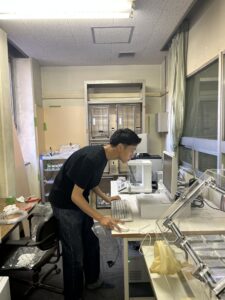FACULTY
教員紹介
FACULTY
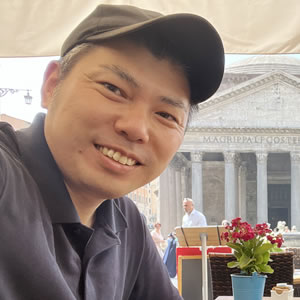
Associate Professor
TERAMOTO Atsushi
寺本 篤史 准教授
建築耐震工学研究室
Earthquake and Structural Engineering Laboratory
専門
材料,センシング,非破壊診断,住環境微生物など建築の端っこを異分野の方々と一緒に取り組んでいます。
We are working with different fielders on the edges of architecture, including materials, sensing, non-destructive diagnostics, and living environment microbiology.
研究の概要説明
当研究室では鉄筋コンクリート部材を中心とした構造部材,内外装を研究対象としています。基盤研究として,鉄筋コンクリートの耐久性評価,維持管理に取り組み,その一端としてpHセンサの開発の共同研究を推進しています。また,長期的な性能予測に資する基盤データの収集,劣化予測モデルの構築に加えて,鉄筋コンクリートに期待されているCO2固定能の評価にも取り組んでいます。
構造部材,内外装材いずれの材料にも適用可能な新しい非破壊診断技術として,微生物の群集構造に着目した研究を進めています。これは微生物生態学分野との共同研究で,本研究を通して取得できる微生物群集構造データを生かして,微生物住環境を制御するための材料開発にも取り組む予定です。
以上のように,従来の建築分野における研究分野から,その少し外側の領域をテーマとし,異分野研究者の方々と共に取り組んでいます。
Our research focuses on reinforced concrete members, mainly structural members, interior and exterior. As a basic research, we are working on durability evaluation and maintenance of reinforced concrete, and as a part of this, we are promoting joint research on the development of pH sensors. In addition to the collection of basic data that contributes to long-term performance prediction and the development of deterioration prediction models, we are also working on the evaluation of CO2 fixation capacity, which is expected of reinforced concrete.
As a new non-destructive diagnostic technique applicable to both structural members and interior/exterior materials, we are conducting research focusing on microbial community structure. This is a joint research project with the Department of Microbial Ecology, and we are planning to develop materials for controlling microbial living environments by utilizing the microbial community structure data obtained through this research.
As described above, we are working with researchers in other fields on themes slightly outside of the conventional research fields of architecture.
現在の研究テーマ
・鉄筋コンクリート構造物の部材性能の将来予測に関する研究
・微生物を活用した建築物の診断方法の提案
・鉄筋コンクリート建築物の性能評価に資するセンシング技術の開発
・鉄筋コンクリートの劣化因子の地域分布に関する研究
・非構造部材の耐震診断技術に関する研究
・補修・耐震補強の評価方法に関する研究
・鉄筋コンクリート造建物のCO2固定量の推定
・Research on future prediction of member performance of reinforced concrete structures
・Proposal of diagnostic method for buildings using microorganisms
・Development of sensing technology that contributes to performance evaluation of RC buildings
・Study on regional distribution of deterioration factors of RC buildings
・Research on seismic diagnosis technology for non-structural members
・Research on evaluation methods for repair and seismic retrofitting
・Estimation of CO2 fixation in reinforced concrete buildings
研究室サイト
-
建築耐震工学研究室
Teramoto Lab.
広大研究者総覧
-
工学 / 建築学 / 建築構造・材料・維持管理
Engineering/ Building Engineering/ Materials, Maintenancehttps://seeds.office.hiroshima-u.ac.jp/profile/ja.7c9adb5f3f96323f520e17560c007669.html
研究・プロジェクト内容
材料選定による建築空間の微生物環境の制御に関する基礎的研究
本研究は建築内装材の選定により衛生微生物学的な住環境の向上することを最終目的としている。事業期間においては,代表的な多孔質建築材料であるコンクリートおよび木質材料に着目し,両材料共に建築物の供用期間中に変化する①材料学的条件(空隙構造,表層含水率,pH),および②温湿度環境条件(温度,相対湿度,換気量)が,表層部に生息する微生物の消長(構成種類,量および構成比)にどのような影響を与えるかについて検討を行う。
Fundamental research on control of microbial environment in building space by material selection
The ultimate objective of this research is to improve the sanitary microbiological living environment through the selection of building interior materials. In the project period, we will focus on concrete and wood materials, which are typical porous building materials, and investigate how (1) materialological conditions (pore structure, surface moisture content, pH) and (2) temperature and humidity environmental conditions (temperature, relative humidity, ventilation), which change during the service life of both materials, affect the extinction (composition type, amount and composition ratio) of microorganisms living in the surface layer of the building. (species, amount, and composition ratio) of microorganisms inhabiting the surface layer.
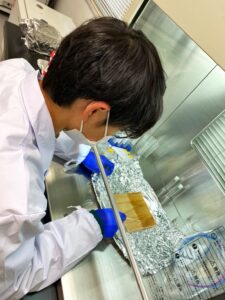
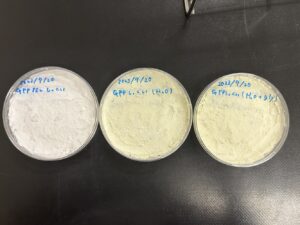
微生物の多様性指数を用いたコンクリート構造物の劣化診断手法の開発
本研究課題は,世界的に高経年化が進行している既設コンクリート構造物を対象に,コンクリートの劣化を微生物群集の多様性指数によって評価・予測する手法を提案する。本研究チームは,世界的にコンクリート内部の微生物群集の多様性解析の実績をもつMaresca博士と,コンクリート工学および微生物環境を専門とする若手研究者から構成されている。本研究を通してMaresca博士の有する希少な分析・解析ノウハウを若手研究者が修得し国内に還元すること,微生物群集解析の工学的利用法としてどこでも誰でも実施可能なインフラの維持管理システムを提案・発信することを目的とする。
Development of a Deterioration Diagnosis Method for Concrete Structures Using Microbial Diversity Index
This research project proposes a method to evaluate and predict the deterioration of concrete based on the diversity index of microbial communities in existing concrete structures, which are aging at a high rate worldwide. The research team consists of Dr. Maresca, who has a worldwide track record of analyzing the diversity of microbial communities in concrete, and young researchers specializing in concrete engineering and microbial environments. Through this research, we aim to help young researchers acquire the rare analytical know-how of Dr. Maresca and to propose and disseminate an infrastructure maintenance management system that can be implemented anywhere and by anyone as an engineering application of microbial community analysis.
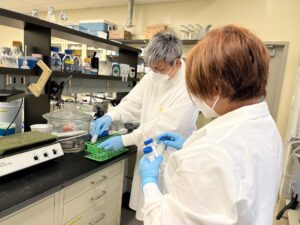


コンクリート構造物に生じたひび割れの時間依存性挙動のモデル化
一般に,ひび割れ補修材と躯体の劣化機構として両者の界面の引張破断を前提とするなら,ひび割れ幅が最大となる時期に補修材の注入を行い,主に圧縮応力が作用するよう配慮した施工が望ましい。しかしひび割れ開閉挙動を適切に把握していない場合,上記の理想的なひび割れ補修工法は多くの場合実施されていない。
本研究の成果を基にすると,補修材には圧縮・引張が繰り返し作用し,加えて補修材そのものの温度変化による物性の変化も考慮しなければならないことがわかる。つまり補修材に十分な耐久性を期待する場合には,想定するひび割れ開閉挙動を正しく理解し,それに適した機能を有する材料の選定が重要であることが改めて確認された。
Modeling the time-dependent behavior of cracks in concrete structures
In general, if tensile failure at the interface between the crack repair material and the building frame is assumed as the degradation mechanism, it is desirable to inject the repair material when the crack width is at its maximum and to apply mainly compressive stresses. However, if the crack opening and closing behavior is not properly understood, the ideal crack repair method described above is often not implemented.
Based on the results of this study, it can be seen that the repaired material is subjected to repeated compressive and tensile actions, and in addition, changes in the physical properties of the repaired material itself due to temperature changes must also be considered. In other words, if sufficient durability is to be expected from the repair material, it is important to correctly understand the expected crack opening and closing behavior and to select a material with the appropriate functionality.
多機能ファイバセンサを用いたコンクリート内部のpH分布の測定手法の開発
コンクリート内部の鉄筋腐食は,鉄筋周辺のpHや塩化物イオン濃度,水分量の影響を受けることが分かっており,鉄筋腐食現象に関連するpHや塩化物イオンを定量的にモニタリング可能な手法が強く望まれている。共同研究者の東北大学・郭媛元助教はイオン濃度の分布を可視化できる半導体化学イメージセンサと,多機能ファイバ技術を組み合わせることによって新しい生体埋め込み型のpH可視化プローブを実現し,このプローブを用いてマウスの脳内のpH変化を経時的にモニタリングすることに成功した。本研究は郭先生が開発したイオン感応膜を集積した多機能ファイバセンサを用いて,コンクリートの表層部から内部へのpHの分布を,連続的かつ長期間にわたって取得する手法を提案する。
Development of a Method for Measuring pH Distribution in Concrete Using a Multifunctional Fiber Sensor
Corrosion of reinforcing bars inside concrete is known to be affected by pH, chloride ion concentration, and water content around the bars, and quantitative monitoring of pH and chloride ions related to the corrosion phenomenon of reinforcing bars is strongly desired. The joint researcher, Assistant Professor Yanyuan Guo of Tohoku University, has realized a new implantable pH visualization probe by combining a semiconductor chemical image sensor that can visualize the distribution of ion concentrations and multifunctional fiber technology, and has successfully monitored pH changes in the brain of mice over time using this probe. The probe was successfully used to monitor pH changes in the brain of mice over time. This study proposes a method to continuously and over a long period of time acquire the distribution of pH from the surface to the interior of concrete using a multifunctional fiber sensor integrated with an ion-sensitive membrane developed by Dr. Guo.
コンクリートにおけるCO2固定量評価の標準化に関する研究開発
本研究開発では,今後,多くのCO2を固定化した建設材料が開発されると想定される中で,標準的に固定化量を評価する手段を提供し,今後,CO2の固定化手段を応用した建設材料の市場において健全な競争を導くとともに,消費者にも適切な材料性能の開示をもたらすことを実現することを目的とする。
東京大学,北海道大学,琉球大学等との共同研究であり,広島大学では壁面に塗装やひび割れがある実構造物のCO2固定能の推定手法の高度化に取り組んでいる。
Research and development on standardization of evaluation of CO2 fixation in concrete
The purpose of this research and development is to provide a standard means of evaluating the amount of CO2 fixation, to lead to healthy competition in the market for construction materials that apply CO2 fixation methods, and to provide consumers with appropriate disclosure of material performance, as it is expected that many CO2 fixation materials will be developed in the future. The purpose of this study is to provide a means to evaluate the amount of CO2 fixation in the construction materials market.
This is a joint research project with the University of Tokyo, Hokkaido University, University of the Ryukyus, and others. Hiroshima University is working on the advancement of methods for estimating the CO2 fixation capacity of actual structures with painted or cracked wall surfaces.
